Related Research Articles

Clitocybe is a genus of mushrooms characterized by white, off-white, buff, cream, pink, or light-yellow spores, gills running down the stem, and pale white to brown or lilac coloration. They are primarily saprotrophic, decomposing forest ground litter. There are estimated to be around 300 species in the widespread genus.

Clitocybe nuda, commonly known as the blewit or wood blewit and alternately described as Lepista nuda, is an edible mushroom native to Europe and North America. Described by Pierre Bulliard in 1790, it was also known as Tricholoma nudum for many years. It is found in both coniferous and deciduous woodlands. It is a fairly distinctive mushroom that is widely eaten. It has been cultivated in Britain, the Netherlands and France.

Lepista is a genus of mushroom-forming fungi. According to the Dictionary of the Fungi, the widespread genus contains approximately 50 species. In 1969, Howard Bigelow and Alex H. Smith designated the group as subgenus of Clitocybe.

Hygrophoropsis aurantiaca, commonly known as the false chanterelle, is a species of fungus in the family Hygrophoropsidaceae. It is found across several continents, growing in woodland and heathland, and sometimes on woodchips used in gardening and landscaping. Fruit bodies (mushrooms) are yellow–orange, with a funnel-shaped cap up to 8 cm across that has a felt-like surface. The thin, often forked gills on the underside of the cap run partway down the length of the otherwise smooth stipe. Reports on the mushroom's edibility vary – it is considered poisonous, but has historically been eaten in parts of Europe and the Americas.

The Tricholomataceae are a large family of fungi within the order Agaricales. Originally a classic "wastebasket taxon", the family included any white-, yellow-, or pink-spored genera in the Agaricales not already classified as belonging to e.g. the Amanitaceae, Lepiotaceae, Hygrophoraceae, Pluteaceae, or Entolomataceae.

Ampulloclitocybe clavipes, commonly known as the club-foot or club-footed clitocybe, is a species of gilled mushroom from Europe and North America. The grey brown mushrooms have yellowish decurrent gills and a bulbous stalk, and are found in deciduous and conifer woodlands. Although considered edible, disulfiram-like reactions have been reported after consumption of alcohol after eating this mushroom.

Aspropaxillus giganteus, also Leucopaxillus giganteus, commonly known as the giant leucopax or the giant funnel, is a saprobic species of fungus in the order Agaricales. As its common names imply, the fruit body, or mushroom, can become quite large—the cap reaches diameters of up to 50 cm (20 in). It has a white or pale cream cap, and is funnel-shaped when mature, with the gills running down the length of the stem. Considered by some to be a choice edible when young, this species has a cosmopolitan distribution, and is typically found growing in groups or rings in grassy pastures, roadside hedges, or woodland clearings. It has been shown to contain a bioactive compound with antibiotic properties.

Hygrophoropsis is a genus of gilled fungi in the family Hygrophoropsidaceae. It was circumscribed in 1888 to contain the type species, H. aurantiaca, a widespread fungus that, based on its appearance, has been affiliated with Cantharellus, Clitocybe, and Paxillus. Modern molecular phylogenetic analysis shows that the genus belongs to the suborder Coniophorineae of the order Boletales.

Paralepista flaccida is a species of mushroom found across the Northern Hemisphere. It is known to form fairy rings.
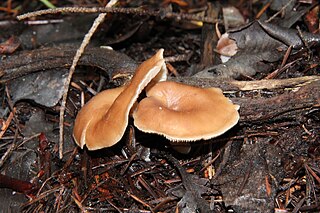
Rhizocybe is a genus of fungus in the order Agaricales. The species resemble Clitocybe and grow amongst litter in predominantly coniferous forests.
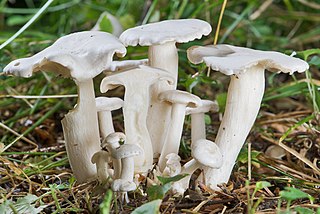
Leucocybe is a recently defined mushroom genus in the family Tricholomataceae. The species resemble Clitocybe and grow in forests or disturbed areas.

Clitocybe subcordispora is a rare species of agaric fungus in the family Tricholomataceae. Found in northern Europe, it was described as new to science in 1969 by Finnish mycologist Harri Harmaja. It is similar to species in the Clitocybe metachroa complex, but can be distinguished from them by its smaller spores, which measure 4.5–6.0 by 3.0–4.0 µm.
Clitocybe strigosa is a species of agaric fungus in the family Tricholomataceae. Found in northern Europe, it was described as new to science in 1969 by Finnish mycologist Harri Harmaja.

Clitocybe agrestis is a species of agaric fungus in the family Tricholomataceae. Widely distributed in Europe it was described as new to science in 1969 by Finnish mycologist Harri Harmaja. Fruitbodies are poisonous as they contain the toxin muscarine.

Clitocybe amarescens is a species of agaric fungus in the family Tricholomataceae. Widely distributed in northwestern Europe, it was first described in 1969 by Finnish mycologist Harri Harmaja. It fruits in groups or in fairy rings in grasslands. Amarescens signifies "tending to bitterness".
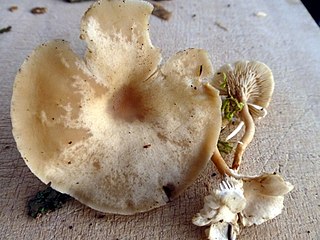
Clitocybe marginella is a species of agaric fungus in the family Tricholomataceae. Found in northern Europe, it was described as new to science in 1969 by Finnish mycologist Harri Harmaja.
Clitocybe ruderalis is a species of agaric fungus in the family Tricholomataceae. Found in northern Europe, it was described as new to science in 1969 by Finnish mycologist Harri Harmaja.
David Norman Pegler is a British mycologist. Until his retirement in 1998, he served as the Head of Mycology and assistant keeper of the herbarium at the Royal Botanic Gardens in Kew. Pegler received his BSc from London University in 1960, thereafter studying tropical Agaricales with R.W.G. Dennis as his graduate supervisor. He earned a master's degree in 1966, and a PhD in 1974. His graduate thesis was on agarics of east Africa, later published as A preliminary agaric flora of East Africa in 1977. In 1989, London University awarded him a DSc for his research into the Agaricales.
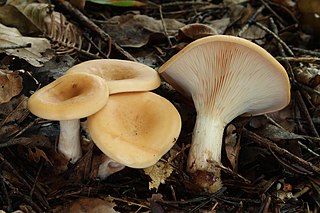
Paralepista is a genus of mushrooms in family Tricholomataceae. Until 2012, its member species were generally assigned either to Lepista or to Clitocybe.
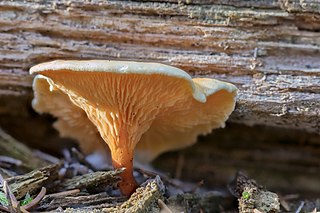
Bonomyces is a genus of fungi in the family Biannulariaceae. Basidiocarps are agaricoid, similar to those of Clitocybe, but with a distinctly hard stipe (stem). The genus is separated on DNA characteristics as well as morphology. Species are known from Europe, North Africa, and northern China.
References
- ↑ Vizzini A, Musumeci E, Murat C (2010). "Trichocybe, a new genus for Clitocybe puberula (Agaricomycetes, Agaricales)". Fungal Diversity. 42 (1): 97–105. doi:10.1007/s13225-010-0030-8. hdl: 2318/101307 . S2CID 20600504.
- ↑ Kuyper TW. (1983). "A new species of Clitocybe". Sydowia. 36: 173–75.